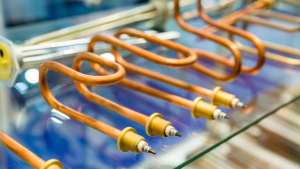Optimizing HVAC for Labs and Test Chambers
Laboratories and test facilities are unique environments that require exacting standards for temperature and air quality. For professionals overseeing such sensitive spaces, understanding the specific requirements and challenges of HVAC systems in these settings is crucial. In this post, we’ll review the why and how of HVAC optimization for labs and test facilities, offering expert insight and actionable advice.
Why Labs Need Special HVAC Considerations
Laboratories often engage in activities that are sensitive to environmental conditions. Whether it’s a pharmaceutical lab where temperature variations can affect chemical reactions, or an electronics lab where humidity and static electricity can damage equipment- precise control over the indoor environment is paramount. This necessitates an HVAC system that is not just reliable, but also capable of meeting rigorous standards.
Key Elements in HVAC Design for Labs
1. Temperature Control
Precise temperature regulation is critical in a lab environment. Equipment like electron microscopes and analytical balances can be affected by even minor temperature fluctuations.
2. Humidity Management
Likewise, managing humidity levels is essential to prevent mold growth or damage to sensitive instruments.
3. Air Quality and Filtration
High-quality air filters and proper ventilation are vital. The air may need to be filtered or purified to remove contaminants that could skew test results or damage equipment. Regulating airflow is critical in labs to help prevent cross-contamination between different zones. HEPA and ULPA filters essential for trapping particles and contaminants.
4. Energy Recovery Systems
Labs require constant air changes which can be energy-intensive. An energy recovery system can capture and reuse energy from exhaust air to heat or cool incoming fresh air.
5. Redundant Systems
Finally, because downtime can be disastrous in many testing scenarios, redundancy is key for lab HVAC systems. Given the significant consequences of HVAC system failure in a lab environment, redundancies should be built into the design, ensuring that if one component fails, another can take its load. Backup systems ensure continuity of operations.
Considerations for Various Lab Types
Different labs require different HVAC strategies. For example:
- Chemical Labs: Robust exhaust systems are necessary to manage fumes.
- Biological Labs: Containment and biosecurity are top priorities, affecting both filtration and airflow patterns.
- Electronics Labs: Climate control to manage static and cool delicate equipment is essential.
Test Chambers
The realm of test chambers is witnessing significant advancements in HVAC (Heating, Ventilation, and Air Conditioning) systems, crucial for maintaining precise environmental conditions. The latest iterations of these systems boast improved energy efficiency and incorporate cutting-edge technologies like IoT connectivity and machine learning algorithms. These innovations allow for meticulous control and monitoring, enabling the HVAC units to adapt in real-time to varying test parameters. Additionally, modern test chamber HVAC systems are being designed for greater compatibility with a diverse range of testing scenarios, ensuring that regardless of the test chamber’s application—whether it be electronics testing, pharmaceutical stability, or automotive endurance—the climatic conditions can be altered rapidly and maintained with exceptional accuracy. This not only augments the reliability of test results but also reduces the overall operational costs by minimizing energy waste and optimizing performance.

Regular Maintenance Is Key
Maintaining an HVAC system in a lab is not just about fixing it when it breaks. Proactive maintenance is far more important to prevent downtime. This includes:
- Routine Inspections: Scheduled inspections can catch issues before they become problems.
- Filter Replacements: Keeping up with filter changes can prevent loss of airflow and system efficiency.
- Calibration Checks: Regular calibration of sensors and controls is necessary to ensure they’re accurately reading conditions within the lab.
Challenges and Solutions
Maintaining such precise conditions is fraught with challenges. Not only are the systems complex, but they must often operate 24/7, consuming large amounts of energy and needing consistent maintenance.
Innovative Maintenance Strategies
A key strategy is employing smart maintenance which uses sensors and IoT (Internet of Things) technology to predict and prevent system failures before they occur.
Zoning
Zoning can allow different areas of a facility to maintain different conditions without the need for multiple systems. This is critical in multi-use facilities where different labs may have vastly different requirements.
Controls
Investment in high-quality control systems is non-negotiable. Modern digital controls can allow for more precise adjustments and can be monitored remotely for convenience.
Training
Continuous training and education of HVAC professionals and facility staff on the specific needs and operation of these complicated systems is also vital to maintain their efficiency and reliability.
Conclusion
The demand for high-performance HVAC systems in laboratories and test facilities is growing, as is the complexity of these installations. By understanding the nuances of HVAC needs in these environments, professionals can ensure that these critical spaces can operate without a hitch, maintaining the integrity of their work and the safety of their equipment.
HVAC industry professionals must stay up to date with the latest technologies and practices to meet the high stakes of this dynamic field. For property and facility managers, working closely with skilled HVAC teams is the best guarantee for creating and maintaining an environment that meets the rigorous standards necessary for successful laboratory and test facility operation.
Remember, the right environment is not just about comfort—it’s about enabling the future discoveries and innovations that labs and test facilities are working towards every day. Your work is crucial, and so is the climate it’s conducted in.
For more insights and assistance on commercial HVAC systems, follow us on social! Or contact our offices for information about our services.
New Hudson, MI #248.486.6500
West Branch, MI #989-999-4822













